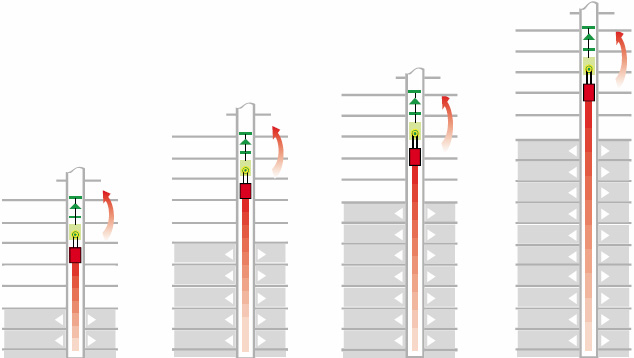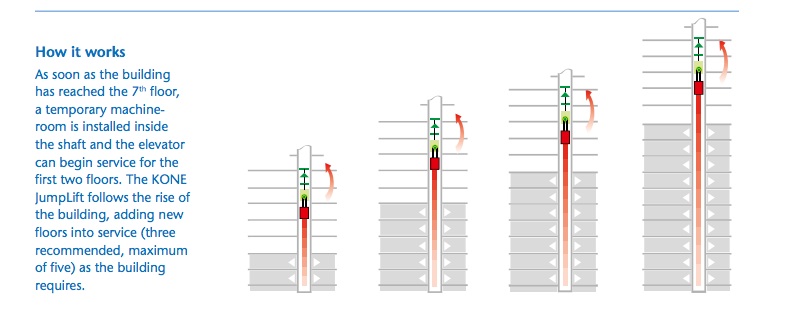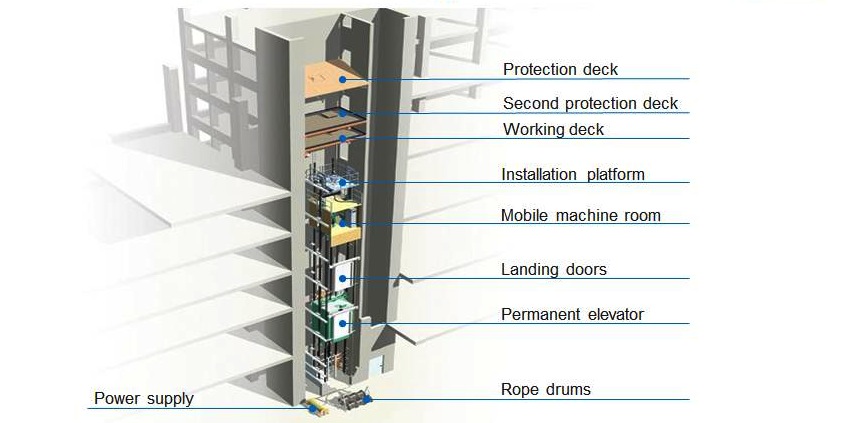Elevator and escalator manufacturer KONE Inc. announced the first North American installation of the company's JumpLift technology. The system is being implemented on the One Bloor project, Great Gulf’s flagship high-rise condominium under construction in Toronto.
KONE JumpLift, which has already been installed in Europe, Asia, the Middle East, China, and Australia, is an advanced, self-climbing elevator that operates during construction in a building’s permanent hoistway. JumpLift uses a mobile machine room that moves upward as the construction progresses.
The technology can improve safety and efficiency on job sites and can enable buildings to be completed months ahead of traditional construction timelines.
Great Gulf and KONE are collaborating on the project, which will deliver high-end retail and residential units in Toronto’s Bloor-Yorkville area, and is expected to be completed in 2016.
The KONE JumpLift technology includes the following benefits:
• Less wait time: Operating at speeds up to 800 fpm (4m/s), five times faster than a traditional external hoist used in construction, KONE JumpLift is able to move construction workers to their floors in a faster, safer way.
• Safer transportation: With all transportation activities taking place inside in a dry and windproof shaft, construction workers can safely move throughout the building regardless of weather conditions, allowing building construction to proceed unhindered.
• Construction efficiency: Using the building’s permanent elevator hoistway for construction use, completed floors can be put into action while allowing the installation to continue above.
• Faster delivery: When the building structure is completed, changing over to the permanent elevator is a straightforward matter of installing the final machinery and finishing the material surfaces of the elevator car, landing doors and signalization.
“Great Gulf always looks for innovation in design and construction. One Bloor, recently recognized by the International Property Awards as the best hi-rise condominium in North America, is one of the most significant buildings being built in Toronto,” said Christopher Wein, President Great Gulf Residential. “The KONE JumpLift provides real value and this elevator technology will help the entire construction project to proceed more efficiently and safely for everyone working on site.”
Related Stories
| Aug 11, 2010
Great Solutions: Business Management
22. Commercial Properties Repositioned for University USE Tocci Building Companies is finding success in repositioning commercial properties for university use, and it expects the trend to continue. The firm's Capital Cove project in Providence, R.I., for instance, was originally designed by Elkus Manfredi (with design continued by HDS Architects) to be a mixed-use complex with private, market-...
| Aug 11, 2010
Seven tips for specifying and designing with insulated metal wall panels
Insulated metal panels, or IMPs, have been a popular exterior wall cladding choice for more than 30 years. These sandwich panels are composed of liquid insulating foam, such as polyurethane, injected between two aluminum or steel metal face panels to form a solid, monolithic unit. The result is a lightweight, highly insulated (R-14 to R-30, depending on the thickness of the panel) exterior clad...
| Aug 11, 2010
Nurturing the Community
The best seat in the house at the new Seahawks Stadium in Seattle isn't on the 50-yard line. It's in the southeast corner, at the very top of the upper bowl. "From there you have a corner-to-corner view of the field and an inspiring grasp of the surrounding city," says Kelly Kerns, project leader with architect/engineer Ellerbe Becket, Kansas City, Mo.
| Aug 11, 2010
AIA Course: Historic Masonry — Restoration and Renovation
Historic restoration and preservation efforts are accelerating throughout the U.S., thanks in part to available tax credits, awards programs, and green building trends. While these projects entail many different building components and systems, façade restoration—as the public face of these older structures—is a key focus. Earn 1.0 AIA learning unit by taking this free course from Building Design+Construction.
| Aug 11, 2010
AIA Course: Enclosure strategies for better buildings
Sustainability and energy efficiency depend not only on the overall design but also on the building's enclosure system. Whether it's via better air-infiltration control, thermal insulation, and moisture control, or more advanced strategies such as active façades with automated shading and venting or novel enclosure types such as double walls, Building Teams are delivering more efficient, better performing, and healthier building enclosures.
| Aug 11, 2010
Glass Wall Systems Open Up Closed Spaces
Sectioning off large open spaces without making everything feel closed off was the challenge faced by two very different projects—one an upscale food market in Napa Valley, the other a corporate office in Southern California. Movable glass wall systems proved to be the solution in both projects.
| Aug 11, 2010
AIA course: MEP Technologies For Eco-Effective Buildings
Sustainable building trends are gaining steam, even in the current economic downturn. More than five billion square feet of commercial space has either been certified by the U.S. Green Building Council under its Leadership in Energy and Environmental Design program or is registered with LEED. It is projected that the green building market's dollar value could more than double by 2013, to as muc...
| Aug 11, 2010
Thrown For a Loop in China
While the Bird's Nest and Water Cube captured all the TV coverage during the Beijing Olympics in August, the Rem Koolhaas-designed CCTV Headquarters in Beijing—known as the “Drunken Towers” or “Big Shorts,” for its unusual shape—is certain to steal the show when it opens next year.
| Aug 11, 2010
World's tallest all-wood residential structure opens in London
At nine stories, the Stadthaus apartment complex in East London is the world’s tallest residential structure constructed entirely in timber and one of the tallest all-wood buildings on the planet. The tower’s structural system consists of cross-laminated timber (CLT) panels pieced together to form load-bearing walls and floors. Even the elevator and stair shafts are constructed of prefabricated CLT.
| Aug 11, 2010
Integrated Project Delivery builds a brave, new BIM world
Three-dimensional information, such as that provided by building information modeling, allows all members of the Building Team to visualize the many components of a project and how they work together. BIM and other 3D tools convey the idea and intent of the designer to the entire Building Team and lay the groundwork for integrated project delivery.









